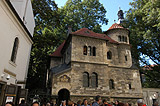More about Jewish Town
 The old Jewish cemetery is the only reminder of old Prague Jewish Town, otherwise cleared away during “the asanation” (the demolition) in the 19th Century. Since its founding (the 15th Century), the limited grounds gave rest to thousands. The most visited tomb is that of Rabbi Jehuda Löw, the „inventor” of Golem, the legendary clay giant. Never mind this story, Löw was without a doubt a very educated man of many virtues, with interest in alchemy and possibly magic but that’s hard to say, since anything having to do with chemistry and physics was seen as magic at the time.
The old Jewish cemetery is the only reminder of old Prague Jewish Town, otherwise cleared away during “the asanation” (the demolition) in the 19th Century. Since its founding (the 15th Century), the limited grounds gave rest to thousands. The most visited tomb is that of Rabbi Jehuda Löw, the „inventor” of Golem, the legendary clay giant. Never mind this story, Löw was without a doubt a very educated man of many virtues, with interest in alchemy and possibly magic but that’s hard to say, since anything having to do with chemistry and physics was seen as magic at the time.
The town covered one tenth of the present size of Old Town, which means it was quite overcrowded as the population grew with centuries. Six gates separated it from the rest of the city, gates which were locked all day and night during the Easter. That was the tiniest of acts of oppression towards the minority. The pogroms did occur and reasons were various: the city was struck by cholera or some other illnesses, explainable as a punishment from (Christian) God by anti- Semite radicals. One of the gravest pogroms took place in 1389, during the reign of Wenceslas IV, the son of Charles IV. A catholic priest was wounded while walking through the quarter. The fanaticized crown stormed the ghetto, burning down houses and killing whoever got into its reach. Majority of the then- current Jewish population (which is thought to have been about three thousand), fell victim to the rampage that was probably encouraged by the clergy.
The modern times of the Jewish quarter, now called Josefov, brought little progress to the town. The new quarter remained poor and was damaged by high crime rate and an unfriendly stance of the city majority. In literature, the area was traditionally a setting for dark mysteries and horror tales. Jan Neruda was possibly the first Czech author to write objective reports on the state of living of the Prague Jews, so opening the door for more young writers to approach the community as a serious problem (meaning their social situation) and not an object of fear and/or hatred.
Contemporary population consists of an estimated 1,700 Prague Jews. The community conducts a kinder garden, a home for the elderly, various seminars and, of course, religious services in the synagogues.
The Jewish Town got into the daily news recently, as the magistrates finally forbade neo- Nazi groups from having a march on the anniversary of Kristallnacht (the extremists feebly tried to argue it’s just a coincidence). A right decision, for any kind of celebration or even renaissance of the European majority’s former conduct towards the community would be, in my opinion, extremely shameful.
17th International Fair for Languages, Education and Cultures Eye to Eye with Wild Animals